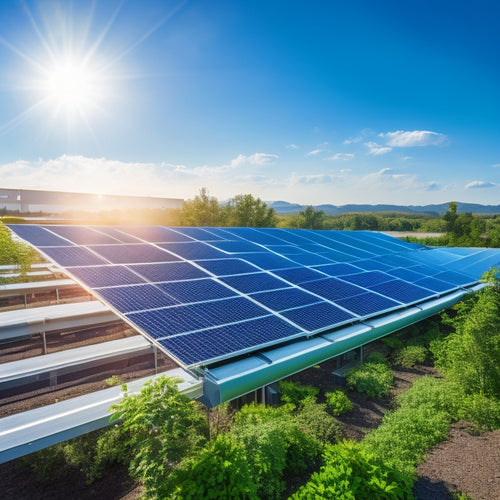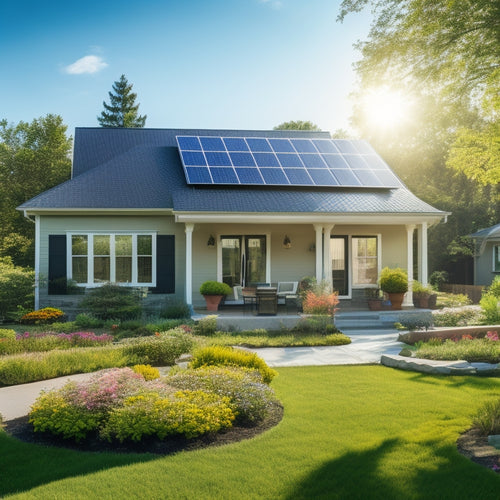
Compare Residential Solar Panel Efficiencies Online
Share
When comparing residential solar panels online, look at efficiency ratings which measure sunlight conversion. High-efficiency panels like those from SunPower and LG achieve over 20% efficiency, requiring less space and providing quicker returns on investment. Key factors include panel orientation, maintenance, and sunlight exposure. Tools like SolarEdge monitoring can help analyze performance. Consider both cost-per-watt and durability for long-term value, and opt for panels with minimal degradation rates. Efficient panels maximize energy output while reducing the visual footprint on your property. Gain deeper insights by exploring specifics of each brand's tech and efficiency metrics.
Key Takeaways
- Review efficiency ratings and conversion rates of top-rated panels like SunPower and LG.
- Consider the cost-per-watt analysis to evaluate financial benefits.
- Compare the durability and degradation rates to assess long-term performance.
- Examine space requirements and optimal panel placement for maximum efficiency.
- Utilize monitoring systems like SolarEdge to track and compare individual panel outputs.
Understanding Solar Panel Efficiency
https://www.youtube.com/watch?v=GEZO67JJ19I
To comprehend solar panel efficiency, you need to grasp how effectively a panel converts sunlight into usable electricity. Fundamentally, efficiency is about the conversion rate of sunlight hitting the panel's surface and the amount of electrical energy it produces. This efficiency hinges on the performance of photovoltaic cells within the panels.
Photovoltaic cells are the core components responsible for converting solar energy into electrical power. They achieve this by absorbing photons and releasing electrons, thereby generating electricity. The conversion rate is quantified as a percentage, representing how much sunlight the cells can convert into usable power. For instance, a panel with a 20% conversion rate means that 20% of the sunlight it captures is converted into electricity, while the rest is lost as heat or reflected away.
You might think higher efficiency directly translates to better performance, but it's vital to analyze the context. Factors like geographical location, panel orientation, and shading can also impact the overall system performance. Still, understanding the intrinsic efficiency of photovoltaic cells gives you a baseline to compare different residential solar panels, paving the way for an informed and liberating choice.
Key Factors Influencing Efficiency
While understanding photovoltaic cell efficiency provides a baseline, it's important to recognize that several key factors greatly influence the actual performance of residential solar panels.
Sunlight exposure directly impacts how much energy your panels can generate. Ideal placement should maximize exposure to sunlight throughout the day, free from shading caused by trees or buildings. The angle and orientation of your panels also play an essential role. Panels should ideally face south in the Northern Hemisphere and north in the Southern Hemisphere to capture the most sunlight.
Weather conditions are another significant factor. Overcast skies can reduce solar panel output by up to 90%. Rain, snow, and even dirt accumulation can further diminish efficiency. High temperatures can also negatively affect performance as photovoltaic cells operate less efficiently in extreme heat. However, modern panels are designed to mitigate some of these losses through advanced technologies like anti-reflective coatings and temperature-resistant materials.
Lastly, maintain regular upkeep. Cleaning your panels to remove dirt and debris can result in a 5-10% increase in efficiency. Monitoring systems can help you track performance and identify issues promptly, ensuring your investment continues to provide maximum energy liberation.
Top-Rated Solar Panels Comparison
When comparing top-rated solar panels, you'll find significant differences in efficiency ratings, which directly impact energy output.
Balancing cost versus performance is essential, as higher efficiency panels often come with a premium price tag.
Additionally, evaluating durability and lifespan will help you determine the long-term value and reliability of your investment.
Efficiency Ratings Breakdown
Comparing the efficiency ratings of top-rated solar panels reveals significant variations in performance, directly impacting their suitability for different residential applications. You'll find that efficiency improvements among manufacturers can vary widely, often influenced by proprietary technologies and material choices.
For instance, SunPower's Maxeon series boasts efficiencies upwards of 22.7%, leveraging high-purity silicon and unique interdigitated back contact cells. In contrast, LG's NeON R panels offer around 21.7% efficiency, thanks to their advanced cell structure and enhanced temperature coefficient.
These manufacturer variations mean that not all panels perform equally under identical conditions. Some panels, like those from Panasonic, excel in low-light environments due to their heterojunction technology, achieving efficiencies of about 20.3%. Others, like Canadian Solar's HiKu series, may offer slightly lower efficiencies around 19.9% but compensate with larger panel sizes, increasing overall energy output.
Understanding these efficiency ratings is essential when selecting the right panel for your home. Higher efficiency panels generally provide more energy per square meter, ideal for limited roof space. Conversely, slightly lower efficiency panels can still be viable if you have ample installation area.
Cost Vs. Performance
Analyzing the cost versus performance of top-rated solar panels reveals how efficiency ratings directly influence the overall value and return on investment for residential installations. When you evaluate solar panels, focusing on their efficiency—how well they convert sunlight into usable electricity—is essential.
High-efficiency panels, like those from SunPower and LG, often come with a heftier price tag. However, their superior energy output means you'll need fewer panels to meet your energy needs, potentially lowering the overall installation process expense.
For instance, SunPower's X-Series panels boast an efficiency of over 22%, translating to higher energy output per square meter. This efficiency level can lead to a quicker return on investment despite the initial higher costs.
Conversely, budget-friendly panels, such as those from Canadian Solar, offer around 18-19% efficiency. While they're more affordable upfront, you might require more panels to achieve the same energy output, increasing both the installation complexity and costs.
To make an informed decision, compare the cost-per-watt and annual energy savings across different models. By doing so, you'll maximize your financial benefits and achieve energy independence more effectively.
Durability and Lifespan
High-quality solar panels, such as those from SunPower and LG, often boast impressive durability and lifespans, with many offering warranties of 25 years or more.
When evaluating the longevity and robustness of solar panels, you should consider several key factors to make sure you're making a vital investment.
-
Weather Resistance: Top-rated panels are engineered to withstand extreme weather conditions, from heavy snow to intense heat. Check for certifications like the IEC 61730, which assures high safety and weather resistance standards.
-
Degradation Rate: This metric indicates how much a panel's efficiency degrades annually. Leading brands like SunPower have degradation rates as low as 0.3% per year, ensuring long-term performance.
-
Material Quality: Look for panels made from high-grade silicon and advanced encapsulation materials. These components are essential for preventing micro-cracks and moisture ingress, which can have a significant impact on durability.
- Warranty Terms: Extensive warranties cover not just the product but also performance guarantees. A 25-year warranty often signifies a lower degradation rate and better weather resistance.
How to Use Efficiency Tools
To maximize the efficiency of your residential solar panels, leverage specialized tools like PVWatts Calculator and SolarEdge Monitoring to analyze real-time performance data. Start by using online calculators like PVWatts to estimate the potential energy production of your solar panels based on your location, system size, and panel orientation. These tools provide a data-driven projection, helping you make informed decisions about panel placement and expected output.
Next, explore user reviews for insights on how these tools perform in real-world settings. User reviews often highlight practical advantages and potential limitations, offering a thorough understanding beyond technical specifications. For instance, SolarEdge Monitoring allows you to track the performance of individual solar panels, giving you granular data to identify and address inefficiencies promptly.
Utilize these tools to compare different solar panel models. By inputting various parameters, you can assess which panels deliver top efficiency under specific conditions. Combining the analytical capabilities of online calculators with insights from user reviews ensures you make well-informed, effective decisions.
This data-driven approach empowers you to optimize your solar investment, guaranteeing maximum efficiency and long-term sustainability.
Interpreting Efficiency Ratings
Understanding efficiency ratings requires a grasp of how manufacturers measure and report the energy conversion capabilities of solar panels. Efficiency metrics quantify how effectively a solar panel converts sunlight into usable electricity, typically expressed as a percentage. To liberate yourself from high energy costs, you need to interpret these ratings accurately.
Rating interpretation involves several steps:
-
Standard Test Conditions (STC): Manufacturers measure efficiency under controlled conditions—1,000 watts per square meter of sunlight, 25°C temperature, and an air mass of 1.5. These ideal conditions mightn't reflect real-world performance.
-
Temperature Coefficient: Solar panels' efficiency declines as temperature rises. Look for a lower temperature coefficient to secure better performance in hot climates.
-
Power Tolerance: This metric indicates the range within which a solar panel's actual output may vary from its rated output. Positive tolerance (+/-5%) means the panel can produce up to 5% more energy than rated.
- Degradation Rate: Over time, panels lose efficiency. A lower degradation rate (e.g., 0.5% per year) means the panel will remain more efficient longer.
Benefits of High-Efficiency Panels
Investing in high-efficiency solar panels maximizes energy output per square meter, reducing the overall space required for installation. This means you can achieve significant energy savings without having to cover your entire roof with panels. High-efficiency panels convert a larger percentage of sunlight into electricity, which directly translates to higher energy production.
Consider the following data comparison:
| Panel Type | Efficiency (%) | Space Required (sq. meters) |
|---|---|---|
| Standard Panels | 15-18 | 20-25 |
| High-Efficiency Panels | 20-22 | 15-18 |
By opting for high-efficiency panels, you can reduce the number of panels needed and consequently the overall footprint on your property. This reduction not only saves space but can also lower installation costs and minimize the visual impact on your home.
Moreover, high-efficiency panels are particularly advantageous in areas with limited roof space or unconventional layouts. You harness more power from less space, allowing for greater energy autonomy and potential surplus energy generation that can be fed back into the grid.
In essence, high-efficiency solar panels empower you to maximize energy savings while minimizing your system's footprint, making your journey toward energy independence both efficient and effective.
Choosing the Best Panel for Your Home
When selecting the best solar panel for your home, it's important to analyze efficiency ratings, space constraints, and cost-effectiveness to guarantee the highest return on investment. To make an informed decision, focus on the following critical factors:
-
Efficiency Ratings: High-efficiency panels convert more sunlight into electricity, maximizing output. Panels with efficiency ratings above 20% are considered top-tier and can have a substantial impact on your energy savings.
-
Space Constraints: Assess your roof's available space. Smaller roofs benefit from high-efficiency panels that generate more power per square foot, optimizing limited space.
-
Cost-Effectiveness: Balance initial costs against long-term savings. While high-efficiency panels may be pricier, their superior performance often leads to quicker payback periods and greater financial savings over time.
- Installation Process and Warranty Options: Investigate installation complexities and warranty terms. Choose manufacturers that offer extensive warranties (typically 25 years) and streamlined installation processes to ensure reliability and peace of mind.
Frequently Asked Questions
How Long Do Solar Panels Typically Last?
Solar panels typically last 25-30 years. Warranty periods often cover 25 years, though panels degrade about 0.5%-1% annually. Understanding degradation rates helps you maximize efficiency and liberate yourself from rising energy costs longer term.
Can Solar Panels Still Generate Power on Cloudy Days?
Yes, solar panels can still generate power on cloudy days. Despite cloud coverage, they produce about 10-25% of their usual energy output. This allows you to maintain some energy independence even in less-than-ideal conditions.
What Maintenance Is Required for Residential Solar Panels?
Did you know solar panels lose up to 25% efficiency when dirty? You should clean your panels every 6-12 months and remove debris regularly to maintain peak performance. This guarantees maximum energy production and long-term savings.
Are There Government Incentives for Installing Solar Panels?
Yes, there are government incentives for installing solar panels. You can benefit from tax credits and rebate programs, greatly reducing upfront costs. These incentives empower you to achieve energy independence while making a financially sound investment.
How Does the Installation Process Work for Residential Solar Panels?
Worried about roof suitability? Don't be. The installation timeline is often just a few days. Technicians assess your roof's condition, design a custom-fit system, and handle permits, ensuring a seamless, liberating shift to solar energy.
Related Posts
-

Evaluating Solar Power Options for Businesses
Evaluating solar power options for your business can greatly reduce energy costs and enhance sustainability. Start by...
-

Solar Energy Efficiency Improvements for Businesses
Improving solar energy efficiency for your business can lead to considerable cost savings and enhance your sustainabi...
-

Affordable Solar Panels for Home Use
Affordable solar panels offer you a smart way to cut down on energy costs while promoting sustainability. With govern...


